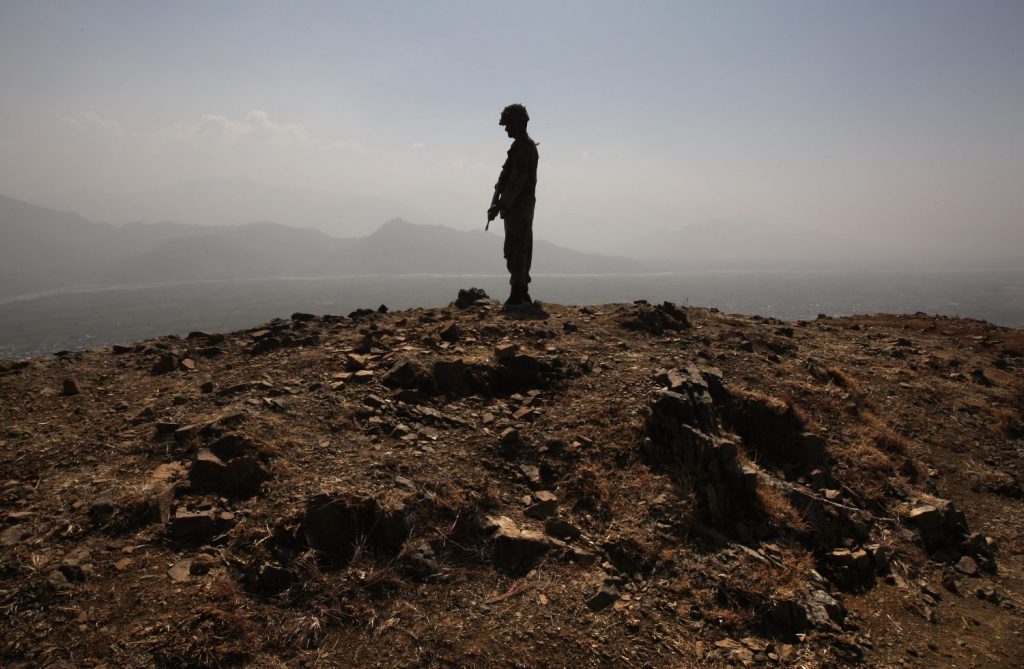 Bottom Line: Current U.S.-Pakistan relations remain strained as the U.S. maintains that Pakistan’s security and intelligence services are doing the minimum to hunt America’s militant enemies within its borders. Pakistani officials have told The Cipher Brief that they have been searching for a way to restart relations despite public humiliation by President Donald Trump earlier this year. Each side wants to keep the other from seeking alternative support – with China wooing Pakistan, and the U.S. growing closer to India.
Bottom Line: Current U.S.-Pakistan relations remain strained as the U.S. maintains that Pakistan’s security and intelligence services are doing the minimum to hunt America’s militant enemies within its borders. Pakistani officials have told The Cipher Brief that they have been searching for a way to restart relations despite public humiliation by President Donald Trump earlier this year. Each side wants to keep the other from seeking alternative support – with China wooing Pakistan, and the U.S. growing closer to India.
Background: U.S-Pakistan bilateral ties have been a rollercoaster from the start.
One of the first events that generated Pakistani distrust of the U.S. and launched what Pakistan perceived as a narrative of betrayal was in 1962 when the Kennedy administration offered military assistance to India, Pakistan’s primary regional rival, during the Indo-Sino border conflict. This was followed by an arms embargo and cessation of aid in 1965 during the outbreak of the first India-Pakistan war.
The bilateral relationship also suffered during the Carter administration when economic assistance was cut between 1977-1979 as Pakistan began its secret uranium enrichment program and again in 1990-2001 when it pursued nuclear weapons. Support was renewed in 2001 when the U.S. entered Afghanistan in its War on Terror.
A repair in the relationship led to Pakistan’s designation as a major non-NATO ally (MNNA) in 2004, granted by then-President George W. Bush primarily for Pakistan’s efforts against Al-Qaeda. With MNNA status, Pakistan gained access to U.S. military technology, surplus defense equipment and training and significant quantities of foreign aid funding.
WikiLeaks documents released in 2010 revealed how well U.S. and Pakistan were connected and cooperated – a level of cooperation that Pakistani officials had not previously acknowledged to their own public. Pakistan in reaction shut down or limited cooperation in several areas, according to former U.S. officials who experienced the blowback, speaking anonymously to describe the controversy. There had been U.S. troops embedded with Pakistani troops along the Afghan border and also serving in an intelligence fusion cell in Peshawar – many of those troops were asked to leave, and communications with top U.S. officials were limited or completely curtailed for a time.
The 2011 U.S. raid on Osama Bin Laden’s compound in Pakistan further damaged the trust between the two countries. The CIA-led raid of U.S. special operators that killed the mastermind of the 9/11 attacks was carried out without Pakistan’s knowledge.
The raid coincided with the controversy over the detention in Pakistan of CIA contractor Raymond Davis earlier in 2011. The former U.S. special operator had killed two Pakistanis he said had attacked him. The U.S. claimed he had diplomatic immunity, but Pakistani officials said he was an undeclared intelligence operative. He was eventually released after the families of the dead Pakistanis were financially compensated for the deaths.
The House of Representatives put forward a bipartisan bill to revoke Pakistan’s MNNA status on Jun. 23, 2017, with Rep. Ted Poe, R-Texas, calling Pakistan the “Benedict Arnold ally of the United States.”
While unveiling the administration’s South Asia Strategy on Aug. 22, Trump singled out Pakistan for giving “safe haven to agents of chaos, violence and terror.”
Two days later U.S. Secretary of State Rex Tillerson said Pakistan’s MNNA status could be revoked: “We have some leverage in terms of aid, their status as a non-NATO alliance partner — all of that can be put on the table.”
On Nov. 23, a Pakistani court released Hafiz Muhammad Saeed, the founder of the U.S. designated terrorist group Lashkar-e-Taiba, and alleged mastermind behind the 2008 Mumbai attacks that killed 166 people. The move was decried by the international community, especially by India and the U.S., as a sign that Pakistan is unwilling to move against terrorist groups that it perceives as assets.
“The U.S. only needs to look to the recent past to remind us of Pakistan’s actions in times of tension and to be able to anticipate what Islamabad will do now in order to decide the most effective policy response to both sustain the relationship and protect U.S. interests during these strained times. Part of the strength is the relationships that countries and people have. I think we’re at another difficult time because of this public humiliation – in the past, our relationship has been under heavy strain, but we still managed to be able to communicate about important issues and events.”
 Richard G. Olson, former U.S. Ambassador to Pakistan and Special Representative for Afghanistan and Pakistan
Richard G. Olson, former U.S. Ambassador to Pakistan and Special Representative for Afghanistan and Pakistan
“I understand why the administration feels it needs to take a tough line – because, frankly, other approaches have not worked. My advice for the administration: first, deliver a tough line as much as possible in private rather than in public because that allows for those who may feel aligned with us in Pakistan not to be identified as U.S. stooges and to argue for cracking down on militants without being identified as supporting U.S. policy. The second point is, I think the United States should engage with Pakistani leadership… there should be an attempt to bring together senior military intelligence and diplomatic personnel and I think you have to have all three legs of that stool present at the table from U.S. and from Pakistan to deliver a very tough message about the need for Pakistan to choose between its relationship with the Haqqanis and the Taliban and its relationship with the United States.”
Issue: The latest spat led the U.S. to suspend nearly $3 billion in military assistance and coalition support funding to Pakistan – more than originally reported in January, according to both U.S. and Pakistani officials this week. Pakistan, in return, decreased some intelligence sharing with the U.S., Pakistani officials tell The Cipher Brief. The relationship between the CIA and Pakistan’s ISI has remained strained, although a phone call by U.S. Central Command’s Gen. Joseph Votel to Pakistan’s Army chief of staff on Jan. 12 helped start repairing the military to military relationship.
Trump’s Jan. 1st tweet, claiming the S. had “foolishly” handed Pakistan more than $33 billion in aid over 15 years and received in return, “nothing but lies and deceit” prompted Pakistan to make the unusual move of summoning U.S. Ambassador to Pakistan David Hale for a sharp rebuke, and to demand an explanation of the president’s tweet.
A senior U.S. administration official said about $1.5-$2 billion worth of current and previous year planned military assistance and $900 million in Coalition Support Funding (CSF) have been suspended, which “reflects the frustration that we have not seen tangible evidence that Pakistan has made a strategic decision to crack down on all terrorists and militants, mainly the Haqqani network and the Taliban who find shelter on their territory.”
Long-time Pakistan critic, Senator Rand Paul, posted a video Jan. 4 proposing to end all aid to Pakistan, reassigning the funds to infrastructure projects in the U.S. “The U.S. should not give one penny to countries who burn our flag and chant death to America. Countries like Pakistan that stonewall access to key information in fighting terrorism.” On Jan. 6, Trump tweeted his approval: “Good idea Rand!”
On Jan. 9, Pakistan released Sufi Mohammad – a radical anti-U.S. cleric who went to Afghanistan with thousands of volunteers to help the Taliban fight against Americans after the 2001 U.S.-led invasion. These incidents are widely seen as a thumb in the eye to the U.S.
Pakistan’s defense minister Khurram Dastgir Khan stated on Jan. 11 that some intelligence-sharing with the U.S. would be halted and that Islamabad was still considering preventing U.S. forces from using Pakistan as a land route to Afghanistan. A member of parliament from the ruling Pakistan Muslim League-Nawaz party suggested raising the fee charged to use the route to compensate for the lost aid.
Pakistan denounced a Jan. 24 U.S. drone strike that killed Haqqani network leader Nasir Mehmood and two aides in the Kurram tribal region of northwestern Pakistan, which is considered one of the group’s safe havens. Islamabad claimed that the area is home to Afghan refugees and that the strike violated Pakistan’s sovereignty.
During questioning at U.S. think tank CSIS on Jan. 22, Pakistan’s ambassador to the U.S., Aizaz Ahmad Chaudhry, insisted, “When somebody turns around and tells us that there are safe havens, we say to them please show us where…. When somebody says that your military or your intelligence is actually playing a double game and supporting these militants and I would ask them go and meet those officers and soldiers who have lost their children and their loved ones in the attacks by militants and then you tell me that they would allow their own fellow servicemen to support those people who killed their children. No, sir. It’s not so.”
There have been multiple incidents over the past decades when Pakistan has closed the Ground Lines of Communication (GLOCs), i.e. the crossing points from Pakistan into Afghanistan, which NATO forces use to truck in about half their supplies. More sensitive supplies like ammunition, weapons and sensitive technical equipment are flown in, but water and food and building supplies travel through two main border crossings: Chaman and Torkham. Certain supplies also flow into Afghanistan through the northern distribution network (NDN) across Kazakhstan and Uzbekistan. The NDN could also be used for all supplies if Islamabad denies access, but it would be far more difficult.
When Pakistan closed the GLOCs between November 2011 and July 2012 in retaliation for 24 Pakistani soldiers being killed by NATO forces along the border, the cost of delivering supplies into landlocked Afghanistan skyrocketed from $17 million to $104 million a month. Closed GLOCs would also divert key assets from the battlefield to managing the delivery of supplies.
“From my perspective, the very public criticism in President Trump’s tweets was the catalyst for the current tensions, because the tweets publicly called into question Pakistan’s capability and capacity, which is a red line for most countries. Effective diplomacy is all about relationships – the ability to maintain a relationship during difficulty and difference – and the very public approach that this White House has taken makes it harder for our diplomats and other U.S. government representatives to work through this as we have in the past. I look back at the Bin Laden raid and their initial reactions were pretty good. It wasn’t until the Washington news cycle hit and people got in front of cameras and talked about how bad Pakistan was, that everything went south. It’s the public humiliation that really is the trigger.”
“Pakistan still has leverage when it comes to access for supply and retrograde. This leverage is reduced because there are fewer U.S. and NATO forces in Afghanistan, but the United States still needs to supply these forces and also Afghan forces. And U.S. force levels are currently increasing once again. It remains unclear whether the United States could use the Northern Distribution Network as an alternative, especially given the current state of U.S.-Russia relations and the need to move lethal equipment into and out of Afghanistan. The bigger issue would be if Pakistan halted U.S. access to its air space. This would impact America’s use of drones, its ability to fly supplies into and out of Afghanistan (including lethal equipment, I believe), and to conduct other aerial operations there.”
Response: While State Department and Pentagon officials have emphasized the importance of maintaining ties with Pakistan, and senior administration officials have stressed the cessation of aid is a signal to Pakistan’s security services, not its government, members of Congress have proposed bills to re-appropriate all of the funds that will go towards projects in Pakistan. Trump tweeted his approval of one of the proposed bills, leaving a message seemingly at odds with others in his administration.
After Trump’s New Year’s day tweet, State Department and national security officials stressed that the suspension in aid is temporary and could be lifted if progress were achieved. Recognizing the civil-military divide in Pakistan, the officials also emphasized that the administration did not suspend economic or civilian assistance.
A senior U.S. national security official said on Jan. 5 that “We have suspended security assistance, but we have not suspended economic and civilian assistance because it is the military and ISI (Pakistan’s Inter-Services Intelligence) – and of course the ISI is staffed by military officers – that really control the policies toward the militant and terrorist groups.” The official added, “Nothing’s been reprogrammed, we’re hopeful that we can lift the suspension, and the aid would be able to go forward.” The aid that continues to flow amounts to roughly $250 million annually, U.S. and Pakistani officials say, which goes mostly to economic development and infrastructure projects.
This was reiterated by Deputy Secretary of State John Sullivan at a Feb. 6 Senate Foreign Relations Committee hearing when he stated: “We may consider lifting the suspension when we see decisive and sustained actions to address our concerns, including targeting all terrorist groups operating within its territory, without distinction.”
Defense News reported that S. chairman of the Joint Chiefs of Staff General Joe Dunford is hopeful that military relationships could mend the current political divide between Washington and Islamabad. “I’m committed to try to improve the relationship, and I do believe a military-to-military dialogue led by [Gen. Joseph Votel, commander of U.S. Central Command] with occasional reinforcement by [Secretary of Defense Jim] Mattis, myself and others, is the right approach.” He added, “Do we agree on everything right now? No, we don’t. But are we committed to more effective relationship with Pakistan? We are, and I’m not giving up on that.”
Congressional critics of Pakistan, meanwhile, have continued to push for a harder line through proposed legislation. On Feb. 5, the House introduced a companion bill to a late January Senate bill that would prohibit the Department of State and the United States Agency for International Development (USAID) from sending American taxpayer dollars to Pakistan, redirecting those funds – $1.28 billion from State and $852 million from USAID – to the Highway Trust Fund. Trump tweeted his approval of the bill, which aligns with his domestically focused “America First” agenda.
“From the U.S. side, it is key to not engage in bluster, and to be more cognizant of the reactions of the Pakistani public, which in turn impact its government’s actions. There is also a need to find ways to communicate with the Pakistani public that the U.S. intends to maintain civilian aid to the country (as seems to be the policy right now) — that America’s contention is not with the Pakistani public, but with the Pakistani military’s (alleged) support of the Haqqanis.”
Looking Ahead: In the public sphere, the U.S.-Pakistan relationship may continue on a downward trajectory for a period, reflecting domestic political environments, including an “America First” agenda in the U.S. and a rising tolerance for extremist groups and anti-American sentiment in Pakistan. However, as both countries stand to benefit from continued economic and military cooperation despite a number of diverging core interests, the relationship will likely recover if dialogue between government interlocutors can bridge the trust deficit. The relationship will still remain at risk of public flare-ups over another incident or confluence of events, which could further entrench the long held Pakistani narrative of betrayal and encirclement, making it a more intractable element of their political discourse. Likewise, provocative actions on the Pakistani side or an attack on U.S. troops by the Taliban or Haqqani Network would further erode trust and political support in the U.S. for continued aid and diplomatic ties.
“It’s hard to tell how real this [recent flare up] is, from the outside looking in. In the past, even in the most difficult of times, each side has found ways to communicate on important issues and events. How this will evolve will depend on our ability to have a synchronized and coordinated approach across the whole of government to handle this situation. The U.S. needs a broader approach that takes into account a strategic view of the US-Pakistani relationship—especially in terms of a more acute assessment of the triggers and impacts defining US-Pakistani relations and the risks to regional stability and U.S. interests, especially in terms of support to coalition forces in Afghanistan, Counterterrorism efforts, Pakistan’s nuclear arsenal, and issues involving India.”
“The American calculus should include what a Pakistan reaction might inflict on Pakistan. The ground lines of communication involves Pakistani economic benefits as well; the trucks moving through Pakistan, they buy gasoline – the truck companies are all Pakistani – a several hundred million dollar enterprise. So Pakistan has to weigh that as well before it shuts it down. With intelligence-sharing, Pakistan has to think: we don’t have satellites in the sky – the Americans do. We don’t have the National Security Agency, the Americans do. So will our refusal to share intelligence result in Americans refusal to share intelligence? And will that then cost us more? The fact of the matter is Pakistan may have human capabilities on the ground, the United States has superior intelligence gathering capabilities. Pakistan benefits from the intelligence relationship as much If not more than the U.S. does. So I personally am not that moved by these little stories that Pakistan decides not to share intelligence…. What the United States and Pakistan need at some point is an honest conversation – what does Pakistan want? Pakistan should see this is not just about a hundred million here or a hundred million there. This is about our place in the world, and you have to take it in totality.”




No comments:
Post a Comment